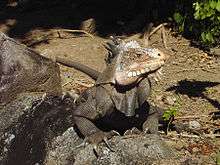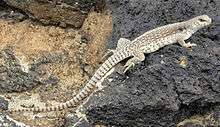Iguanidae
| Iguanas Temporal range: Early Cretaceous-Holocene | |
|---|---|
| Scientific classification | |
| Kingdom: | Animalia |
| Phylum: | Chordata |
| Class: | Reptilia |
| Order: | Squamata |
| Suborder: | Iguania |
| Clade: | Pleurodonta |
| Family: | Iguanidae Oppel, 1811 |
| Genera | |
|
Amblyrhynchus | |
The Iguanidae are a family of lizards composed of iguanas and related species.[1]
Classification
Several classification schemes have been used to define the structure of this family. The "historical" classification recognized all New World iguanians, plus Brachylophus and the Madagascar oplurines, as informal groups and not as formal subfamilies.[2]
Frost and Etheridge (1989) formally recognized these informal groupings as families. This view is not generally accepted.[3][4]
Macey et al. (1997), in their analysis of molecular data for iguanian lizards recovered a monophyletic Iguanidae and formally recognized the eight families proposed by Frost and Etheridge (1989) as subfamilies of Iguanidae.[5]
Schulte et al. (2003) reanalyzed the morphological data of Frost and Etheridge in combination with molecular data for all major groups of Iguanidae and recovered a monophyletic Iguanidae, but the subfamilies Polychrotinae and Tropidurinae were not monophyletic.[6]
Townsend et al. (2011), Wiens et al. (2012) and Pyron et al. (2013), in the most comprehensive phylogenies published to date, recognized most groups at family level, resulting in a narrower definition of Iguanidae.[7][8][9]
Historical classification
Family Iguanidae
- Informal grouping anoloids: anoles, leiosaurs, Polychrus
- Informal grouping basiliscines: casquehead lizards
- Informal grouping crotaphytines: collared and leopard lizards
- Informal grouping iguanines: marine, Fijian, Galapagos land, spinytail, rock, desert, green, and chuckwalla iguanas
- Informal grouping morunasaurs: wood lizards, clubtails
- Informal grouping oplurines: Madagascan iguanids
- Informal grouping sceloporines: earless, spiny, tree, side-blotched and horned lizards
- Informal grouping tropidurines: curly-tailed lizards, South American swifts, neotropical ground lizards
Frost et al. (1989) classification of iguanas
Family Corytophanidae
Family Crotaphytidae
Family Hoplocercidae
Family Iguanidae
- Genus Amblyrhynchus – marine iguana
- Genus Brachylophus – Fijian/Tongan iguanas
- Genus Conolophus – Galápagos land iguanas
- Genus Ctenosaura – spinytail iguanas
- Genus Cyclura – West Indian rock iguanas
- Genus Dipsosaurus – desert iguana
- Genus Iguana – green and Lesser Antillean iguanas
- Genus Sauromalus – chuckwallas
- Genus Armandisaurus (extinct chuckwalla)
- Genus Lapitiguana giant Fijian iguana
- Genus Pumilia (extinct Palm Springs iguana)
- Genus Pristiguana (Cretaceous Brazilian iguana)
Family Opluridae
Family Phrynosomatidae
Family Polychridae
Family Tropiduridae
Macey et al. (1997) classification of Iguanidae
Family Iguanidae
- Subfamily Corytophaninae: casquehead lizards
- Subfamily Crotaphytinae: collared and leopard lizards
- Subfamily Hoplocercinae: wood lizards, clubtails
- Subfamily Iguaninae: marine, Fijian, Galapagos land, spinytail, rock, desert, green, and chuckwalla iguanas
- Subfamily Oplurinae: Madagascan iguanids
- Subfamily Phrynosomatinae: earless, spiny, tree, side-blotched and horned lizards
- Subfamily Polychrotinae: anoles, leiosaurs, Polychrus
- Subfamily Tropidurinae: curly-tailed lizards, neotropical ground lizards, South American swifts
Schulte et al. (2003) classification of Iguanidae
Here families and subfamilies are proposed as clade names, but may be recognized under the traditional Linnean nomenclature.
Iguanidae
- Corytophaninae: casquehead lizards
- Crotaphytinae: collared and leopard lizards
- Hoplocercinae: wood lizards, clubtails
- Iguaninae: marine, Fijian, Galapagos land, spinytail, rock, desert, green, and chuckwalla iguanas
- Oplurinae: Madagascan iguanids
- Phrynosomatinae: earless, spiny, tree, side-blotched and horned lizards
- Polychrotinae: anoles, leiosaurs, Polychrus
- subclade of Polychrotinae Anolis: anoles
- subclade of Polychrotinae Leiosaurini: leiosaurs
- subclade of Leiosaurini Leiosaurae:
- subclade of Leiosaurini Anisolepae:
- subclade of Polychrotinae Polychrus
- Tropidurinae: curly-tailed lizards, neotropical ground lizards, South American swifts
- subclade of Tropidurinae Leiocephalus: curly-tailed lizards
- subclade of Tropidurinae Liolaemini: South American swifts
- subclade of Tropidurinae Tropidurini: neotropical ground lizards
Townsend et al. (2011), Wiens et al. (2012) and Pyron et al. (2013) classification of Iguanidae
- Family Corytophanidae
- Family Crotaphytidae
- Family Dactyloidae
- Family Hoplocercidae
- Family Iguanidae
- Family Leiocephalidae
- Family Leiosauridae
- Family Liolaemidae
- Family Opluridae
- Family Phrynosomatidae
- Family Polychrotidae
- Family Tropiduridae

 Lesser Antillean iguana, Dominica, W.I.
Lesser Antillean iguana, Dominica, W.I.
 Iguana iguana (American iguana), in Greece, 2008
Iguana iguana (American iguana), in Greece, 2008
 Iguana found in the Florida Keys, diving into the sea
Iguana found in the Florida Keys, diving into the sea A desert iguana from Amboy Crater, California
A desert iguana from Amboy Crater, California
References
- ↑ Bauer, Aaron M. (1998). Cogger, H.G.; Zweifel, R.G., eds. Encyclopedia of Reptiles and Amphibians. San Diego: Academic Press. pp. 140–142. ISBN 0-12-178560-2.
- ↑ Etheridge, Richard; de Queiroz, Kevin (1988). Estes, R.; Pregill, G., eds. Phylogenetic Relationships of the Lizard Families, Essays Commemorating Charles L. Camp. Stanford, California: Stanford University Press. pp. 283–368. ISBN 0-8047-1435-5.
- ↑ D.R. Frost & R. Etheridge (1989) «A phylogenetic analysis and taxonomy of iguanian lizards (Reptilia: Squamata)» Univ. Kansas Mus. Nat. Hist. Misc. Publ. 81
- ↑ D.R. Frost, R. Etheridge, D. Janies & T.A. Titus (2001) Total evidence, sequence alignment, evolution of polychrotid lizards, and a reclassification of the Iguania (Squamata: Iguania) American Museum Novitates 3343: 38 pp.
- ↑ Macey, J.R., A. Larson, N.B. Ananjeva, and Papenfuss, T.J. (1997) [Evolutionary shifts in three major structural features of the mitochondrial genome among iguanian lizards.] Journal of Molecular Evolution 44: 660-674
- ↑ Schulte II, J.A., J.P. Valladares, and A. Larson (2003) [Phylogenetic relationships within Iguanidae inferred using molecular and morphological data and a phylogenetic taxonomy of iguanian lizards.] Herpetologica 59: 399-419
- ↑ Townsend; Mulcahy; Noonan; Sites Jr; Kuczynski; Wiens; Reeder (2011). "Phylogeny of iguanian lizards inferred from 29 nuclear loci, and a comparison of concatenated and species-tree approaches for an ancient, rapid radiation". Molecular Phylogenetics and Evolution. 61 (2): 363–380. doi:10.1016/j.ympev.2011.07.008.
- ↑ Wiens; Hutter; Mulcahy; Noonan; Townsend; Sites Jr.; Reeder (2012). "Resolving the phylogeny of lizards and snakes (Squamata) with extensive sampling of genes and species". Biology Letters. 8 (6): 1043–1046. doi:10.1098/rsbl.2012.0703. PMC 3497141.
- ↑ Pyron; Burbrink; Wiens (2013). "A phylogeny and revised classification of Squamata, including 4161 species of lizards and snakes". BMC Evolutionary Biology. 13: 93. doi:10.1186/1471-2148-13-93.